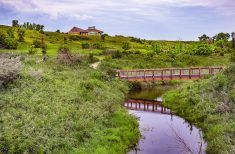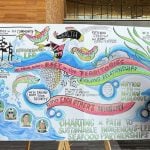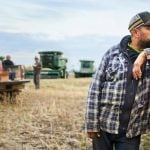LINDELL BEACH, B.C. — The search for ground zero of horse domestication has led researchers to the steppes of northern Kazakhstan.
Sandra Olsen, curator of anthropology at the Carnegie Museum of Natural History in Pittsburgh, Pennsylvania, has conducted archaeological field work in the region since 1993, including the unique horse-dependent Copper Age Botai culture.
The Botai pastoralists lived in the heart of the geographic range of the Tarpan, or European wild horse, on which almost all of their economy depended.
Read Also

Russian wheat exports start to pick up the pace
Russia has had a slow start for its 2025-26 wheat export program, but the pace is starting to pick up and that is a bearish factor for prices.
The landscape of their world was one of open steppe with scattered stands of pine and birch woodland within the 144,000 sq. kilometre drainage of the snow-fed Ishim River.
The climate was one of continental extremes, but it was ideal habitat for horses, red deer, moose, aurochs (wild cattle) and saiga antelope.
The predecessors of the Botai were nomadic hunters, and horses were common prey.
But some time between 3700 and 3100 BC, the culture underwent a radical lifestyle shift as the Botai people created permanent settlements and became more pastoral.
Food in the form of nearby horse bands was plentiful year round. Horses could cope with harsh winter weather, forage by digging in snow and ice, and did not appear to migrate to southern pastures.
The animals provided food, bones for tools, hide for clothing, and manure for roofing insulation.
However, the research has also revealed that they were milked and possibly ridden, 1,000 years earlier than first thought and 2,000 years earlier than the first evidence of domestic horses in Europe.
Kazakhstan Sites Studied
Excavations were conducted at four settlements in north-central Kazakhstan. The largest site was Botai, after which the culture was named, as well as Krasnyi Yar, Roshchinskoe and Vasilkovka IV.
More than 90 percent of animal bones unearthed at the dig sites were horse bones.
Analysis of the remains, particularly limbs, found evidence of possible load-bearing functions and changes related to physical activity.
Botai horses seemed to have slender limbs similar to modern Mongolian domestic horses and specimens from Bronze Age sites in northern Kazakhstan when domestication was widespread. The research team felt the finding could be significant, if still inconclusive.
“(There are) still no clear demarcations on the bones to distinguish wild from domestic,” Olsen said.
“We really don’t have adequate pre-domestic (bones) to compare with Botai ones.”
However, the horse’s significance to Botai culture was clearly obvious and begged questions as to whether horses were hunted and dragged back to settlements, which would have been a daunting task, or whether they were corralled.
Remote sensing detected dark spots in a circular configuration at Krasnyi Yar, indicating post holes and possibly a fence structure.
Soil samples within the structure were compared to samples taken outside.
They were tested for phosphorus, nitrogen and potassium, key mineral ingredients of modern horse manure, as well as associated lipids. The samples revealed elevated levels of the elements, indicating a greater concentration of manure within the structure.
The identification of a possible corral added to the growing evidence of horses being domesticated in Botai.
However, one of the most convincing arguments surfaced when studies indicated that mares were being milked. If so, they had to have been tame and trained to be handled. The clue to that lay hidden in pieces of pottery.
Alan Outram of the University of Exeter’s archaeology department in the United Kingdom collected and analyzed pieces of pottery from Botai and other excavated sites.
A novel method of lipid residue analysis helped prove that the pottery shards contained mares’ milk fat residues, which confirmed the practice of milking mares and storing the liquid in pottery vessels.
“We have indeed got evidence for Botai milking of horses,” said Outram. “The method uses both the stable isotopes of carbon and hydrogen. The carbon can tell us it is horse but does not distinguish milk from meat. The hydrogen gives us a good separation between milk and adipose (animal) fats. This has been demonstrated in modern reference samples and is also seen at Botai.”
It’s likely horses that were corralled and mares that were milked were also harnessed.
Proof of that lies in the many notched horse mandibles found among excavated bone tools. The notching turned these tools into thong smoothers, which would have been used to straighten horse hide. Various lengths of thong could have been shaped into bridles, hobbles, lassoes and bits.
“I believe the thong bridle is the simplest, most expedient and widespread so it would have most likely been the first, given the technological level of the time,” said Olsen.
“Outram et al. cites Robin Bendrey’s discovery of a (certain) kind of bit wear more likely caused by rubbing from the thong bridle. That, I think, has a good chance of being real.”
A bit placed in a horse’s mouth causes a recognizable vertical strip of wear to the mandibular second premolar teeth. The wear may penetrate through the cementum and enamel.
“From the Botai excavations, 15 second premolars displaying full occlusal wear, that is, in excess of four years old, were examined,” Olsen wrote.
“Of nine measurable specimens, No. 7 exhibited changes to the anterior edge that could be unambiguously attributed to bitting damage as evidenced by wear that penetrated through the enamel to expose the dentine. In total, five out of 15 mandibles studied provided evidence of bitting damage.”
Horses were so valuable to the Botai that they took them to the grave.
In one burial site, two men, a woman and a child were laid in a pit surrounded by at least 14 horses, possibly sacrificed as part of a funeral ritual.
Animal Domestication Timeline
Most domestic animals today were domesticated not long after people began farming and living in permanent settlements, between 8000 and 2500 BC.
Canis familiaris domesticated in Asia and possibly elsewhere.
Domestic dogs are descended from wolves (Canis lupus).
10,000 years ago: SHEEP
Ovis aries domesticated in the Middle East.
A tiny stone ram’s head shows a trait that came with domestication: It has smaller horns than the sheep’s closest wild relative, the Asiatic mouflon (Ovis orientalis).
Sus scrofa domesticated Middle East and possibly China.
Most people raise pigs for meat, not transportation. But in some depictions found in Tibet, Marichi, Buddhist goddess of the dawn, travels in a pig-drawn carriage.
8,000 years ago: CATTLE
Bos taurus domesticated in the Middle East.
6,000 years ago: ZEBU CATTLE
Bos indicus domesticated in Pakistan.
Cattle were domesticated more than once, from different branches of the species Bos primigenius, or aurochs. One branch became Bos taurus, the domestic cattle that live in Europe and North America today. Another became Bos indicus, a humped cattle breed.
6,000 years ago: HORSES
Equus caballus domesticated in central Asia.
The DNA of domestic horses is diverse, suggesting they may have been domesticated in more than one place, from several different wild horse populations.
Lama glama domesticated in Peru.
Domestic herds are often allowed to roam freely and over the centuries, they have probably interbred with their wild relative, the guanaco.














